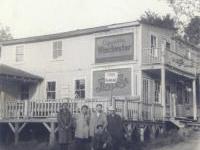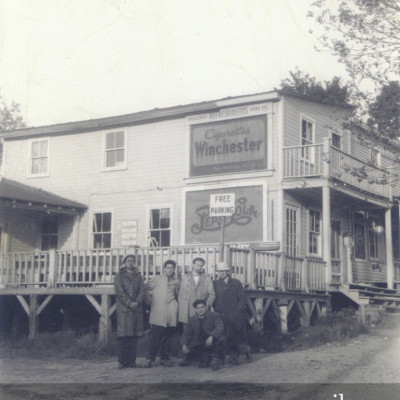--April 5, 2016.
It was not quite dancing in the streets. More accurately, there was a lot of strolling and conversation. Between World Wars I and II Shawbridge was a magnet for the residents of Montreal's teeming Jewish neighbourhoods. Road access was poor but the train made the little community on the lower side of the bridge, across the North River a welcome respite from the city. Shawbridge served as a summer resort destination. There were cottages available to rent weekly or for the season and modest hotel/rooming houses.
 My grandfather, Henry Bishinsky, owned one of the businesses that catered to the seasonal sojourners, a combination snack bar/grocery store on Rue Morin. As grand as this may sound, its footprint was roughly equivalent to a suburban family home. Its large front deck was a magnet on a summer's day. Next to it, also facing Rue Morin, was a two-storey, green, wooden home that accommodated the Bishinsky family on the first floor and provided rooms for rent on the second. Behind the main home were a few small cottages available for rent. Across the street, a competitor -- Hammerman's -- also provided groceries and a snack bar. Between it and the river was a hotel/rooming house. Just beyond Hammerman's, there was a small frame synagogue on Rue Chalifoux.
My grandfather, Henry Bishinsky, owned one of the businesses that catered to the seasonal sojourners, a combination snack bar/grocery store on Rue Morin. As grand as this may sound, its footprint was roughly equivalent to a suburban family home. Its large front deck was a magnet on a summer's day. Next to it, also facing Rue Morin, was a two-storey, green, wooden home that accommodated the Bishinsky family on the first floor and provided rooms for rent on the second. Behind the main home were a few small cottages available for rent. Across the street, a competitor -- Hammerman's -- also provided groceries and a snack bar. Between it and the river was a hotel/rooming house. Just beyond Hammerman's, there was a small frame synagogue on Rue Chalifoux.
The allure of the village was not just the swimming available in the North River or the fresh Laurentian air, but the opportunity for folks to socialize and interact in a tolerant and welcoming environment. During this period, there were many Laurentian communities that were not welcoming to Jews. Yiddish was frequently, if not universally, the dominant language. Lore has it that on a pleasant summer's night the crowds were so large that police would be called to ensure that the road was kept passable as people strolled between the delights of Bishinsky's and Hammerman's debating who had the best ice cream.
Shawbridge's decline as a Jewish summer centre was due to the pollution of the North River and the building of improved highways (Route 117), making the more exotic pull of Sainte-Agathe easily accessible. The Bishinsky store ceased operations in the early 1950s while the little synagogue managed to function until the late 1950s.
Today there is no trace of what was once a vibrant, liberating, summer escape. The only recognizable piece of the landscape is the bridge over the North River. Residential homes exist on the Bishinsky store site.
If the 'Fiddler on a Roof' had emigrated to Canada during Shawbridge's Jewish heyday, he would have felt right at home serenading on top of one of Bishinsky's cottages.
